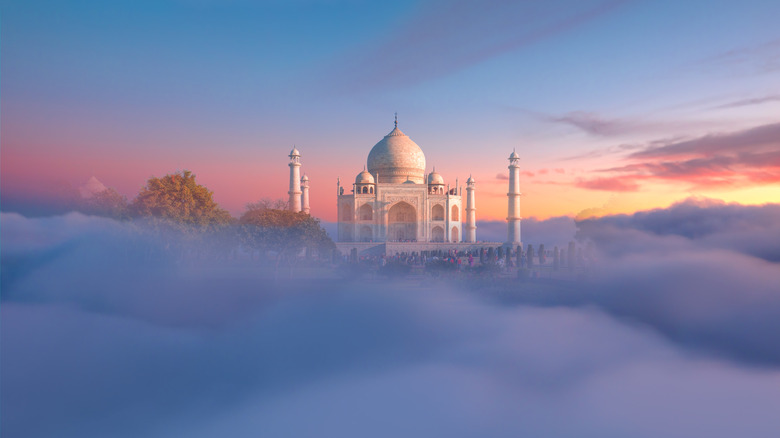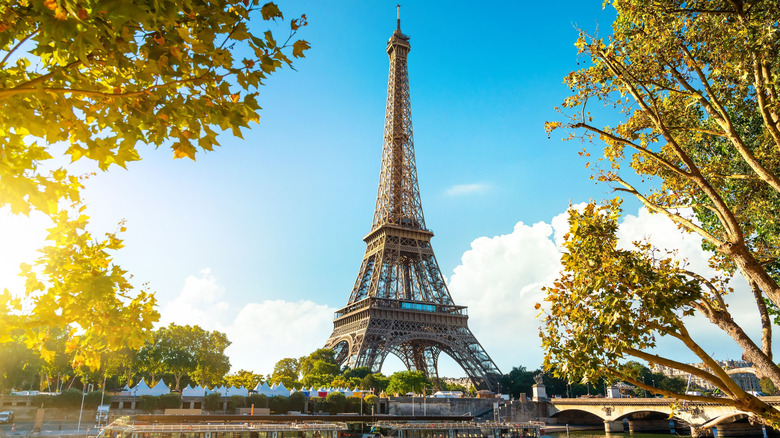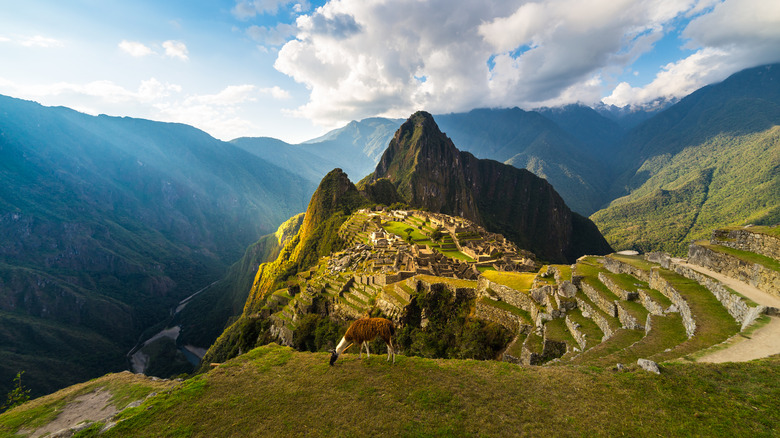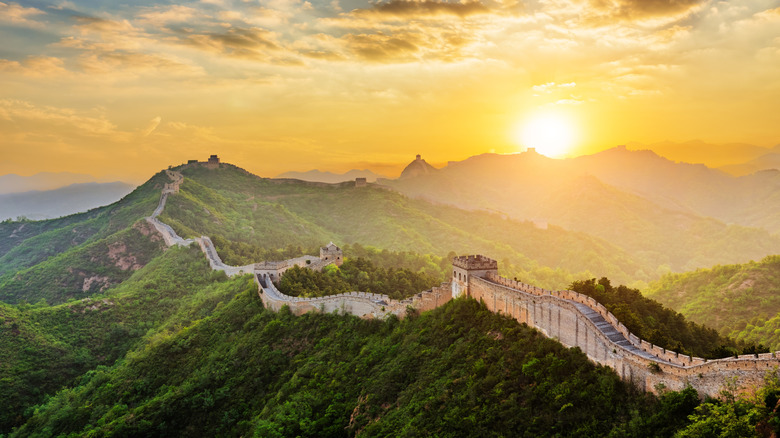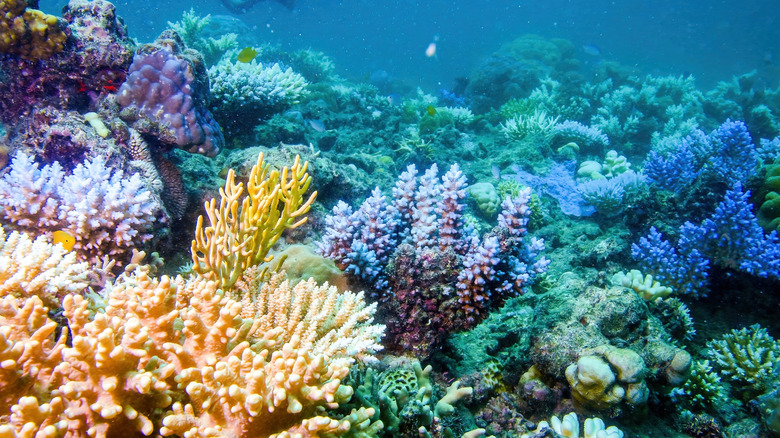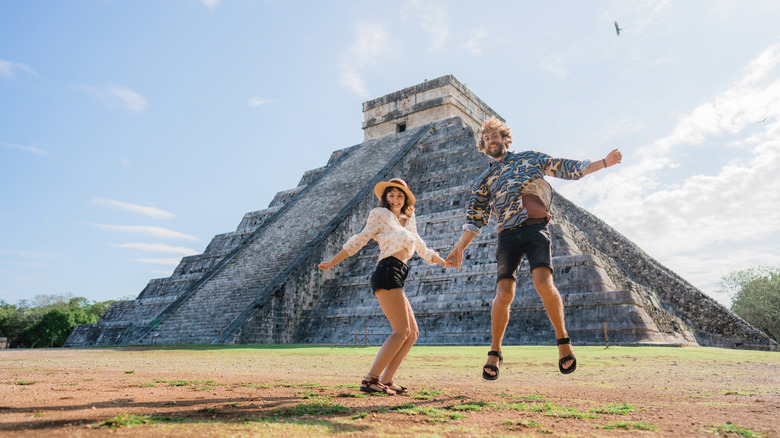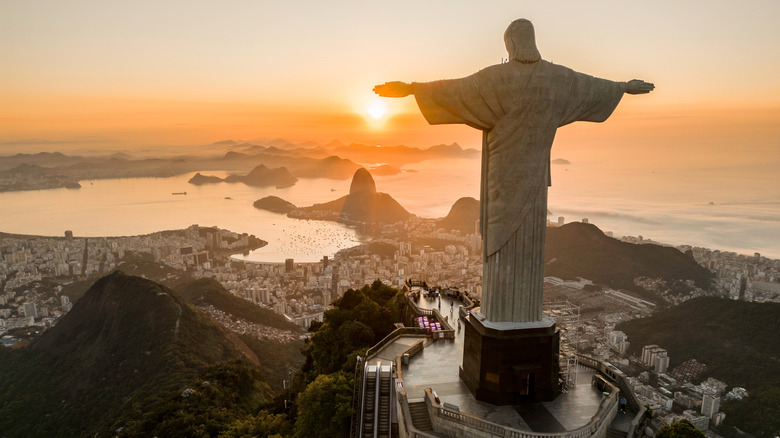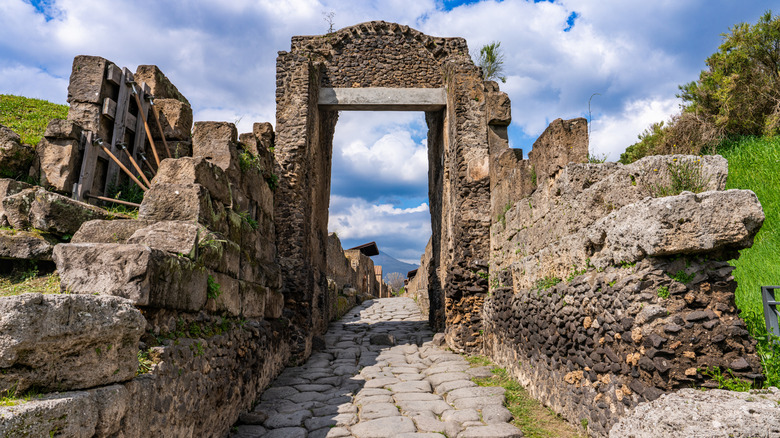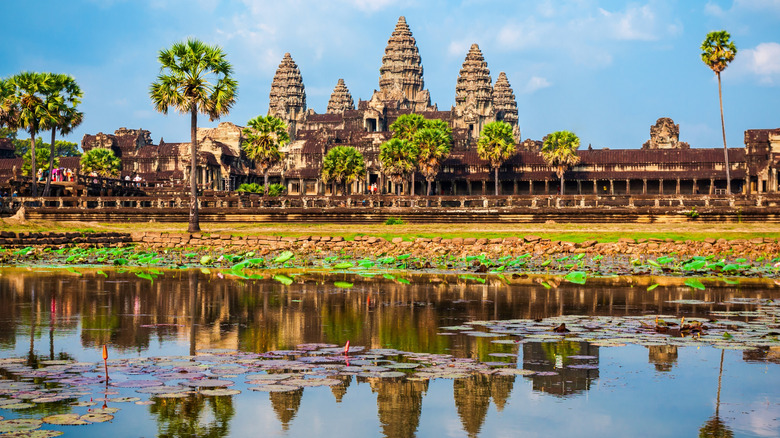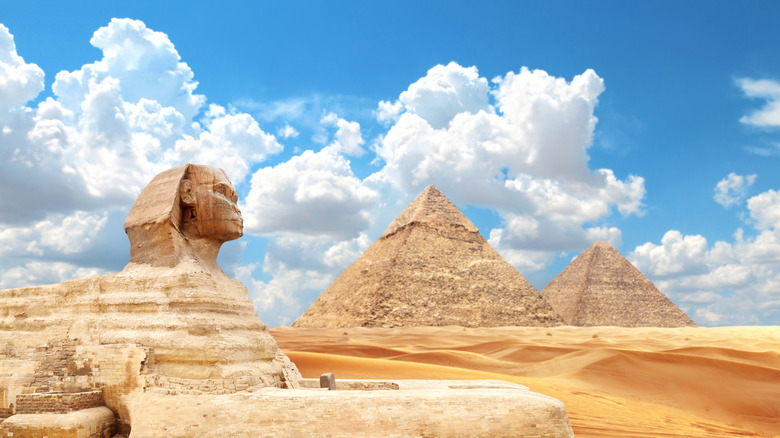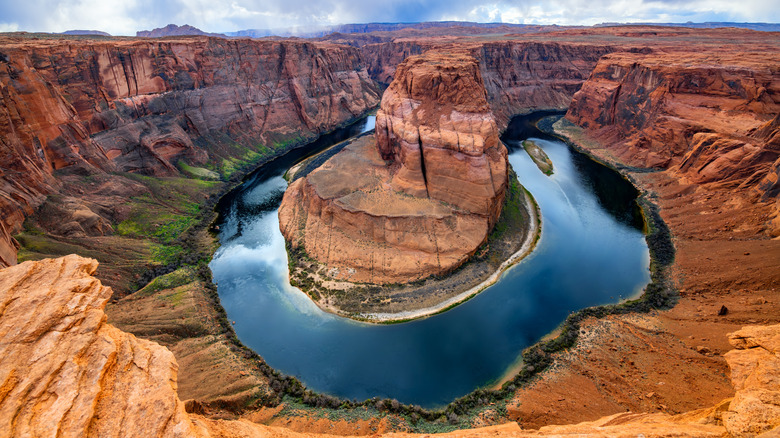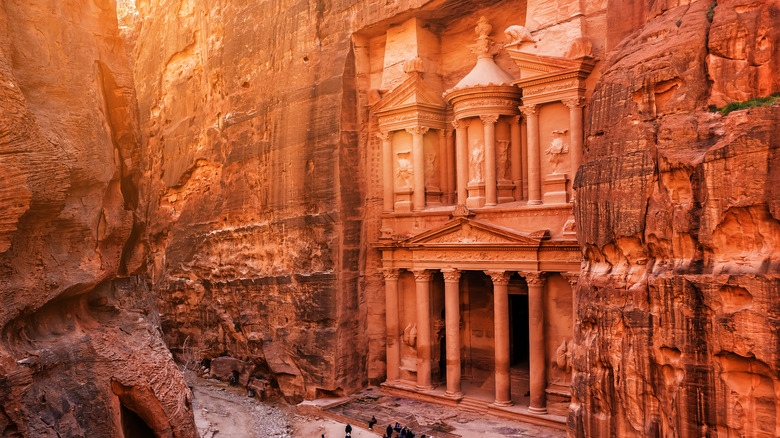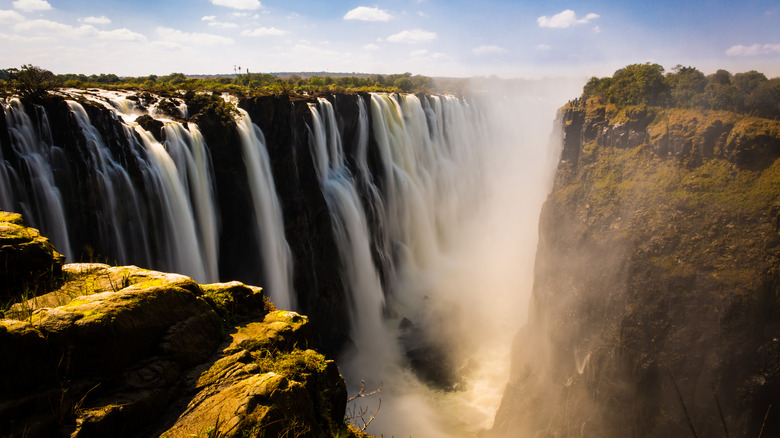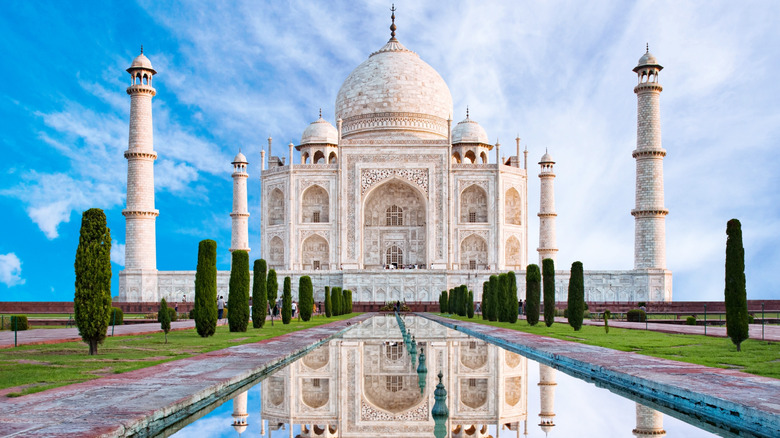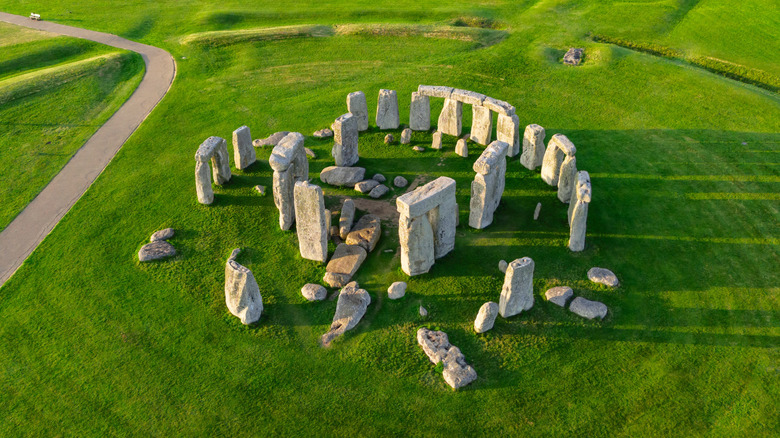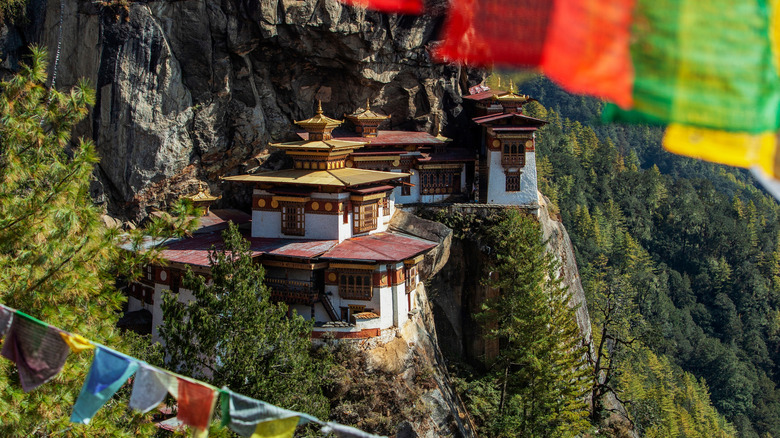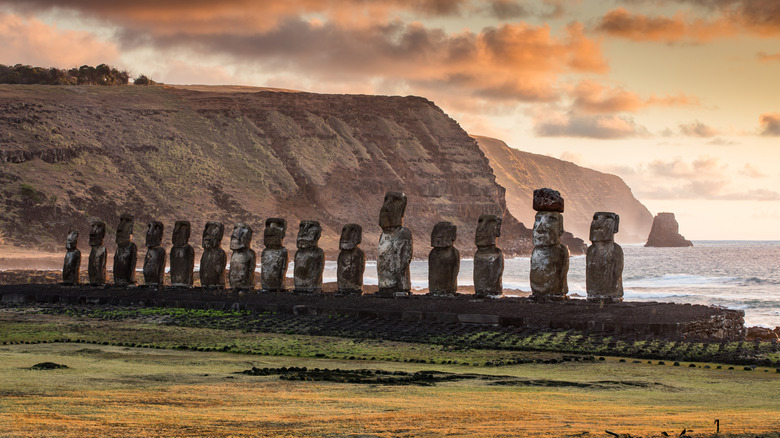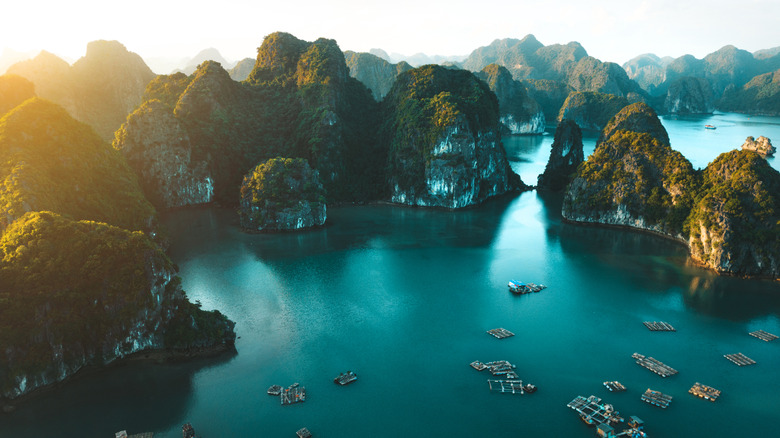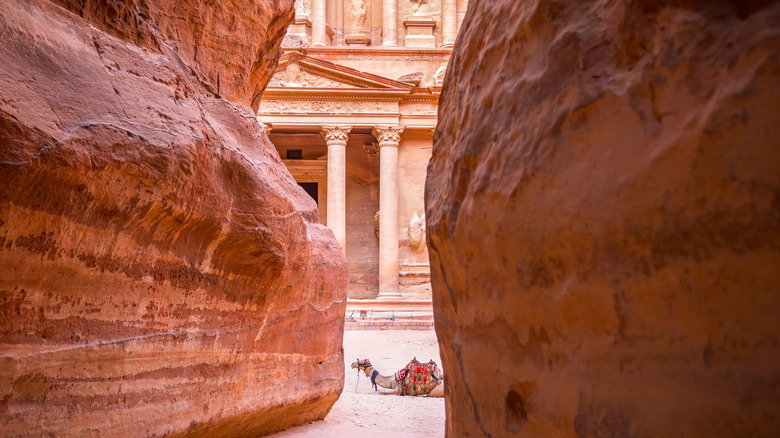The World's 17 Most Iconic Tourist Attractions To Add To Your Bucket List
Not all who wander are lost, life is short, and it's a wide world out there. No matter which cliché you prefer, one thing remains true — travel is incredible. But, let's get back to that "wide world" idea. How is any traveler supposed to decide where to go first? Well, that's where the bucket list comes in.
To compile this list of the most iconic tourist attractions on Earth, we've chosen a mix of wonders from the natural world, historical landmarks, and renowned sites from every corner of the globe, to showcase the immense diversity of our planet. Using a combination of personal experience, the advice of travel experts, trusted travel resources, and visitor reviews, we've created a guide of the world's best places to put on your travel bucket list. After all, "the world is a book and those who don't travel read only one page," according to St. Augustine.
Eiffel Tower, France
Paris is one of the most famous cities in the world, and by far its most recognizable landmark is the Eiffel Tower. Whether spotted from a distance throughout the city or visited up close, you'll never forget you're in Paris when you look at the Eiffel Tower.
Surprisingly, the Eiffel Tower was never meant to be permanent, even though it took over two years and 7,300 tons of iron to complete. Constructed for the 1889 Paris Exposition by Gustave Eiffel and his team, it was only supposed to stand for 20 years. However, Eiffel cleverly turned it into a tool for science, which, in part, helped to secure its place on the city's skyline. Today, the Eiffel Tower stands as the most iconic symbol of Paris.
The famous landmark receives nearly 7 million visitors every year, and is a must for anyone visiting Paris. While it's stunning at any time of the day, it's especially magical after sunset, when 20,000 light bulbs sparkle on the hour until midnight.
Machu Picchu, Peru
While the soaring Andes Mountain Range in Peru is extraordinary in its own right, the mysterious ruins of Machu Picchu are worth seeing at least once in your lifetime. The unofficial "Lost City of the Incas" was hidden in the jungle for centuries, and, despite modern development, it remains difficult to access, which is perhaps part of its appeal. The best way to get to Machu Picchu is hiking the 26-mile Inca trail, or alternatively, a shorter portion of the trail or a bus ride. This ruined city in the mountains near Cusco, the former capital of the Inca Empire, tops many a bucket list for good reason.
Perched at nearly 8,000 feet above sea level, Machu Picchu sits high above the dramatic Urubamba River Gorge. Although its origins are unknown, it was likely built as an estate for the Inca Emperor Pachacuti in 1450, or thereabouts, before its abandonment in the 16th century. Rediscovered in 1911, it has captivated the world ever since.
Great Wall of China
Contrary to its image in the media, the Great Wall of China was never technically "finished," but was a long-ranging project with various pieces added and reconstructed over many dynasties. Nonetheless, the scope is impressive, stretching a total of 13,000 miles and ending right in the Bohai Sea northeast of Beijing. The wall — which also includes signal towers, fortresses, and other military defense structures — stretches through 15 Chinese provinces, with some sections dating all the way back to the 7th century BC.
Various sections of the Great Wall are open to visitors, and guide companies lead multi-day hiking trips along its border as well as to the fascinating unrestored sections known as the "wild Great Wall." The renovated sections easily accessible from Beijing include the dramatic but often crowded Badaling, the scenic section of Mutianyu, and Shanhaiguan Pass, where the wall meets the ocean. Whichever section you choose, you won't regret adding the Great Wall of China to your bucket list.
Great Barrier Reef, Australia
The largest living structure on Earth, the Great Barrier Reef stretches along the coast of Australia for nearly 1,500 miles. As the largest coral reef system in the world, it's one of the few living structures on our planet that can be seen from outer space. The biodiversity of the reef is outstanding, with around 450 species of hard coral alone, along with thousands of fish species — including whale sharks and rays — sea turtles, and more.
To discover the Great Barrier Reef's top islands and natural attractions, head to Cairns, a city on Australia's northeastern coast. The sheer size is hard to fathom, so if possible, see the Great Barrier Reef from both the air and the water by taking a helicopter tour or a sailing trip — in addition to snorkeling, of course. The Great Barrier Reef is also home to dozens of pristine tropical islands, like the picture-perfect Whitsundays. Keep in mind that the reef is a sensitive habitat, so visit responsibly.
Chichen Itza, Mexico
Famous for its standout pyramid, Chichen Itza is actually an ancient Maya city. Chichen Itza is said to mean "at the brim of the well where the wise men of the water live," in part due to its proximity to cenotes, or caves connected to a vast network of underwater rivers. The Sacred Cenote is found on the grounds of Chichen Itza and was once used as a site for ceremonial offerings, its architecture and mystical atmosphere carefully preserved to this day.
For nearly 1,000 years, both Maya and Toltec people inhabited the area, leaving behind astounding examples of art and architecture. The site was abandoned by the 15th century and was lost in the Yucatan region until the 19th century, when excavation began. At Chichen Itza, the main pyramid, called El Castillo, is the highlight. But, there are plenty of other ruins worth seeing, like the Observatory, the Great Ball Court, and the Jaguar Temple.
Christ the Redeemer, Brazil
Part of the allure of Rio de Janeiro's Christ the Redeemer, or Cristo Redentor, is its astonishing views over the coast of Brazil, South America's largest country. The statue itself is impressive, at 98 feet tall with a 92-foot arm span, perched atop the Corcovado Mountain. Built in the 1920s to combat what the Brazilian government saw as a concerning downturn in religiosity, it's now a welcoming symbol of a multicultural city and an iconic landmark visited by people from all over the world.
To visit Christ the Redeemer, take the Corcovado Train from the Cosme Velho Station for a scenic route through the Atlantic forest of Tijuca National Park. The train can get crowded, so do your best to catch the earliest trip of the day to avoid peak visiting hours. If you're looking for more of an adventure, hike the Tijuca Forest trail, which takes around two to three hours.
Pompeii, Italy
An average day in the Roman city of Pompeii turned deadly when nearby Mount Vesuvius exploded, engulfing everything in its path. Today, Pompeii, "destroyed and yet preserved by Mount Vesuvius," according to UNESCO, provides an unmatched window into human life in the year 79 AD. Famously, the flow of volcanic material into the city actually helped to preserve it to an incredible degree, encasing the cavities of bodies, artwork, pieces of fabric, wood, and even food, causing it to essentially become frozen in time. As one Reddit user notes, Pompeii is "the closest thing to time travel we have."
While Pompeii deserves at least a few hours on your itinerary, be sure to stay until the late afternoon when most of the tour groups have moved on. As the World Heritage Site empties out for the day, you'll have the ancient streets to yourself, allowing you to explore the remains of decorated villas, former baths, temples, and the very grid of the city without the crowds. If you're fascinated by history, be sure to add Pompeii to your European bucket list.
Angkor Wat, Cambodia
The incredible Angkor Wat isn't just one temple, but actually a whole series of temples that together make the world's largest religious structure. Angkor was once a royal city, the center of the Khmer Empire, where Angkor Wat was built in the 12th century. The city of Angkor was effectively abandoned by the 15th century, but Angkor Wat remained preserved by the Khmer people and maintained primarily by Buddhist monks, who continue to worshop at the site. Throughout Cambodia's turbulent history, Angkor Wat has remained a symbol of the Khmer people's resilience, and is even featured on the Cambodian flag.
To truly experience this UNESCO Heritage Site, plan to spend at least three days in the province of Siem Reap, which serves as the gateway to Angkor Wat. While Angkor Wat is best viewed at sunrise, the temple city of Angkor Thom is best viewed at sunset. There are over 70 temples to explore at Angkor Wat, such as Ta Prohm, the "tree temple" that made a famous appearance in Angelina Jolie's "Lara Croft: Tomb Raider," and the Bayon Temple with its enormous face carvings.
Pyramids of Giza
The Pyramids of Giza, just outside of Cairo, are the only remaining wonder of the ancient world. They're worth a visit for their age alone, but the architectural mastery, the desolate beauty of the desert, and historical significance make them truly exceptional.
From a distance, the pyramids and their very famous neighbor, the Great Sphinx, seem to rise straight out of the dunes like a dream. Once tombs for great pharaohs Khufu, Khafre, and Menkaure, the pyramids were built during Egypt's Fourth Dynasty, the so-called "Golden Age" of the Old Kingdom from 2613 to 2498 BC. Of the three pyramids, Khufu is the largest, weighing in at approximately 6.5 million tons. The masterful skill and design is astounding, even more so because they were built 5,000 years ago and the exact method of their construction remains a mystery to this day. The pyramids can be tricky to visit, so most experts recommend a tour for ease of access.
Grand Canyon, USA
Carved by the Colorado River over millions of years, the 277-mile-long Grand Canyon stretches for as far as the eye can see. The vast cliffs of the Grand Canyon contain layers of rock that trace back over 1.2 billion years, making it one of the most extraordinary landmarks of the natural world. It is also incredibly biodiverse, home to many species of plants and animals. Even humans have inhabited the Grand Canyon for 12,000 years. For the full experience, visit at sunrise, mid-day, sunset, and under the glow of moonlight.
Another novel way to experience the Grand Canyon is by taking a guided mule trip from the South Rim. If you're up for it, hiking is essential, especially along the Canyon Rim Trail. Visit the North Rim for a whole different perspective, which is now partially reopened after extensive damage from the Dragon Bravo Fire, at the time of this writing. Grand Canyon West features the unique Skywalk, a glass observation platform above the canyon itself.
Petra, Jordan
Deep in the desert canyons of Jordan lies Petra, the "Rose City." The stunning Middle Eastern city of Petra gets its nickname from the reddish rock it's carved from; the intricate buildings protruding out of canyons and caves are unlike anywhere else. Built by the Nabataean people over 2,000 years ago, Petra flourished as a trade link between the Red Sea and the Dead Sea, as merchants imported and exported various exotic goods by caravan.
A devastating earthquake in 363 AD damaged Petra severely — this damage, in combination with shifting trade routes, led Petra to become abandoned by the 7th century. Many centuries later, Petra was rediscovered by a Swiss explorer, sparking new interest in this forgotten city. Now, as one of the world's most famous archaeological sites, Petra is a popular and famous tourist attraction. For this reason, it's best to visit in the off-season to avoid peak tourist crowds. The key sites worth seeing are the famous Treasury, which is especially amazing by candlelight, the Monastery, reachable by over 800 steps, and the Street of Facades.
Victoria Falls, Zambia and Zimbabwe
Victoria Falls, on the border of Zambia and Zimbabwe, is "the world's greatest sheet of falling water," according to UNESCO. Known locally as the Mosi-oa-Tunya or "The Smoke that Thunders," it is one of the seven natural wonders of the world. Victoria Falls stuns with its size, crashing water, surrounding gorge, and many rainbows. The name comes from the distinct thundering sound of the falls, which can be heard for miles around.
Both Zambia and Zimbabwe offer unique experiences that allow you to enjoy and witness the falls in all their glory. However, you'll need the proper travel visas and your passport to travel between the two countries. Mix it up with a sunset cruise on the Zambezi River, a helicopter flight for jaw-dropping aerial views, a swim in the famous Devil's Pool on the very top of the falls, or an exhilarating whitewater rafting trip on the river.
Taj Mahal, India
The Taj Mahal might be the world's most beautiful mausoleum. This magnificent architectural wonder in the Indian city of Agra is considered a symbol of love, not to mention art, beauty, and symmetry. Made from pristine white marble, Taj Mahal was built by the Mughal emperor Shah Jahan in the 17th century for his wife, Mumtaz Mahal, who died during childbirth.
As one of those once-in-a-lifetime vacation destinations, the Taj Mahal can be quite crowded, so consider visiting early in the morning or during the off-season to avoid the biggest crowds. If you happen to be there during the full moon, you can book a special night viewing. The city of Agra offers many opportunities to see the Taj Mahal from other viewpoints. Book a hotel room with a view, explore the Agra Fort, or stroll in the Mehtab Bagh gardens to see the world-famous structure from afar.
Stonehenge, England
The mystical stone circle of Stonehenge in England has mystified humanity for centuries. Despite extensive research, not much is known about Stonehenge. We do know that Stonehenge is approximately 4,500 years old and, based on its unique configuration, was likely built to mark the passage of the sun. The massive stones were brought from as far away as Scotland, but the reason remains unknown.
Until the 1970s, all visitors were permitted to walk among the stones and even touch them. Now, only those who pay for a premium access tour can touch the stones. However, even from a distance, you will likely feel the magic and may even hear their mysterious hum. Be sure to visit the picturesque nearby town of Salisbury and the more accessible Avebury Stone Circle, an equally as impressive UNESCO World Heritage Site.
Tiger's Nest, Bhutan
While Bhutan is known as a mountainous gem of golden temples, it's especially famous for one mountainside temple in particular: Tiger's Nest, also known as Paro Taktsang Monastery. Part of the appeal of the Tiger's Nest is its location, only reachable by hiking through the foothills of the Himalayas, as the monastery buildings are built into a cliffside above the lush Paro Valley. The 4-mile round-trip trek traverses steep stairs and winding paths, with views of the monastery and even a waterfall along the way, making the journey as memorable as the monument itself.
As you may have gathered, Bhutan is not the easiest place to access. Most tourists need a visa and must pay the Sustainable Development Fee of $100 per day. The effort and cost is absolutely worth it, as the "Land of the Thunder Dragon" is unlike anywhere else on Earth.
Easter Island, Chile
Technically part of Chile, Easter Island, or Rapa Nui, is the most remote inhabited place on Earth. But, that's only part of what makes it so unique — it's also home to the famous moai statues. With mainland Chile over 2,000 miles away, and other inhabited islands even father, the original Polynesian settlers were able to create a unique culture, untainted by outside influences for hundreds of years. The famous moai were built between the 10th and 16th centuries, until the Rapa Nui culture began to decline, likely due to resource depletion and colonization, which decimated the island's native population. Subsequently, much of the island's history was also lost, leaving many questions unanswered.
Chile's capital city of Santiago is the main gateway to Easter Island; the only other direct flight departs from Tahiti, French Polynesia. Make sure to hire a local guide when you land. Not only does this help to support Easter Island and its people, but it will also make your trip to the island more immersive and memorable.
Ha Long Bay, Vietnam
Ha Long Bay and the Cat Ba Archipelago are a UNESCO World Heritage Site, comprising over 1,000 islands scattered along the northeastern coast of Vietnam. The rocky, green humps rising dramatically out of the ocean are otherworldly and resemble the curves of a dragon, thus its Vietnamese name, "Descending Dragon Bay." Surrounding the bay are ancient caves and floating villages that belong in another era.
Ha Long Bay is best explored on the water. Overnight cruises include trips to the floating villages, cave excursions, and activities like rock climbing and kayaking. If you have the time, consider spending a night or two on Cat Ba Island, the largest island in Ha Long Bay.
Methodology
Many of the destinations on this list are UNESCO World Heritage Sites, and much of the information presented in this guide was drawn directly from UNESCO resources. Additional insights were gathered from tourism boards and guides by reputable travel experts. Traveler reviews from trusted platforms such as TripAdvisor, as well discussion forums on Reddit, were valuable in helping us refine our selection of destinations and uncover firsthand details about each place. From natural wonders to human achievements, these destinations are widely considered the world's most remarkable and rewarding places to visit.
